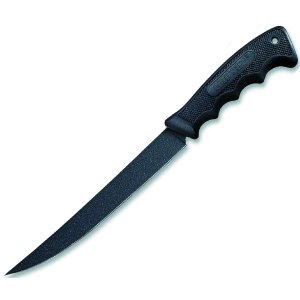

The fillet knife is the best tool in butchering, the sawzall(use 12" wood blade) is a very close second. The sawzall is excellent for the bones but the fillet knife gets all the close cuts. I have a new respect for the art of butchering, it is an art form. I don't think I did too bad on processing the meat, I will say that there is a huge difference between working with the warm body versus the nicely chilled, stiffer body. However, that is not always an easy task for the average home butchering. The day after we butchered the weather warmed up quite a bit and we had to get ice to keep it cool, dry ice was also added. This worked only because we had a box big enough to hold the 2 halves and the ice. There would be no way that our freezer would have been able to hold the 2 sides. Even with a basic cutting, separating the halves in 3, they were far too big to fit both sides.
I had hoped to give a video or at least pictures of the processing but the charger has gone awol. :( Either way, I will be following the following recipe for the bacon and hams. Here is an excerpt of the basic brine:
Basic brine recipe:
6 quarts soft or distilled water, 1 1/2 lb sea salt, 1 1/2 lb brown sugar Herb bag: 1 tbsp crushed juniper berries, 1/2 a nutmeg, 1 bay leaf, 1 tsp peppercorns, 4 cloves
Tie the herbs in a cloth bag. Boil the water, salt and sugar and skim away any froth. Remove the pan from the heat and add the herb bag to steep. Sterilize the crock with boiling water and a baking soda wash. When the brine is quite cold, remove the herb bag, strain it and pour it into the crock, and put the meat in.
You may need to double or triple this recipe, depending on how much of the pig you wish to brine. So here's a larger recipe, assuming you'll be brining the entire pig.
Tanith Tyrr (Bay Gourmet) has done an excellent job on the pig processing FAQ's, check it out.
3 comments:
Most of us up here use old refrigerators that still work..pull out all the racks, plug it in, turn it to the absolute coldest setting...voila! your own meat cooler :) Old yet working units are usually fairly easy to find either free or cheap ;)
Non working units make great smokers too!
Stacy
Stacy, my old fridge is full of beer waiting to be bottled, lol :) I guess I'll have to get another one. :)
LOL! There is always a use for some things I guess! Never thought of beer being one of them, but I guess I can add it to the list :o)
FWIW, we can't get dry ice anywhere within a hundred miles of us, and well, blocks of ice and cubes are just too inconvenient when mass producing meats as we do, so this was an alternative plan. Older deep freezers work rather well too.
Oh! while on that thought..I have a non-working freezer that we keep in the barn for feed. It can be locked and keep nosey animals out, and as far as I can tell, is totally rodent proof. I do have issues with moisture if we keep certain feeds in there, but cracked corn or oats do just fine. Sure, it might not be pretty to keep an old appliance or 3 around, but they can have a functional purpose rather than sitting, rotting in a dump.
Post a Comment